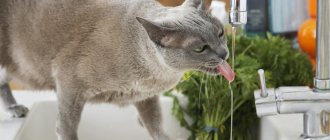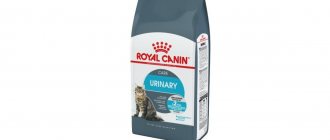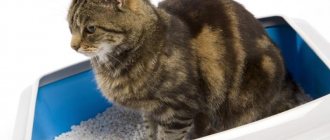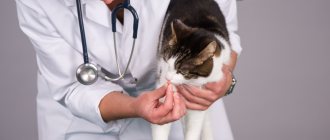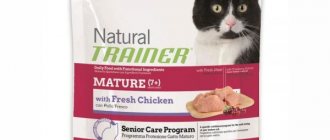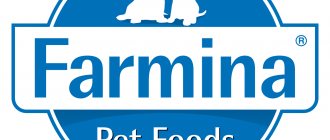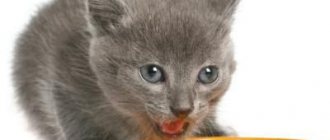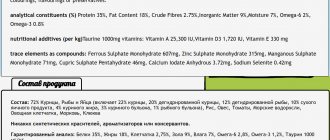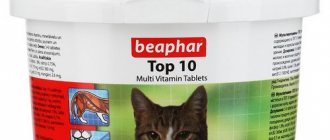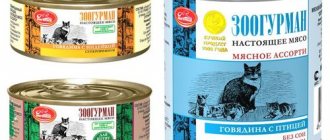Cat lovers living in a high-rise city apartment have to neuter their pet. Otherwise, there is no way to resist the call of nature. But in sterilized cats, the gonads stop secreting hormones, and the intensity and direction of substances changes.
Felinologists and veterinarians recommend using specialized food. And why? What are the dangers of feeding natural products? What ready-made food is needed for cats up to one year old, adults, the elderly, and the elderly? This article talks about premium nutrition from Royal Canin.
Features of nutrition of sterilized cats
Removal of the testes in males and the ovaries and uterus in females affects the functioning of the genitourinary system. Hormonal levels change, the need for energy decreases, and appetite increases.
Metabolism slows down. When choosing the type of power supply, this must be taken into account. Otherwise, illness may occur.
Spayed and neutered pets do not mark their territory, so their bladder is full before each trip to the toilet. They urinate only 1-3 times a day. This can cause sand, crystals and rocks to form. Nutrition should be aimed at diluting concentrated urine. This is exactly what special food for sterilized cats is designed for.
The production of sex hormones (estrogen in females and testosterone in males) stops. Animals become calm, aggression disappears. They do not need to regularly update their marks, look for a partner, or fight with rivals. Their activity decreases. This does not mean that spayed or neutered pets only eat and sleep. They can run and play, but they rarely do this. Therefore, the risk of obesity increases.
Testosterone is not only responsible for masculinity and sex drive, but also maintains optimal weight. Estrogen controls appetite. Stopping the production of these hormones leads to a slowdown in metabolism. Animals want to eat more often and more. This causes the deposition of subcutaneous fat.
The diet of sterilized domestic cats and neutered male cats should be aimed at maintaining a normal weight. Optimal body condition of an animal in itself is the prevention of diseases such as:
- diabetes;
- urolithiasis (UCD);
- fatty liver;
- arthrosis
Only a person can provide a cat with proper nutrition, health and care. It is important to follow the feeding schedule (2 or 3 times a day) and adhere to the daily intake, which is indicated by the manufacturer on the original packaging of the food. For this purpose, the pet must be weighed. It is recommended to feed the animal at the same time.
The diet must be balanced. Homemade food is not the best option for an obligate predator, especially a castrated or sterilized one. It is recommended to feed the animal either natural products (fresh meat and offal with the addition of a small amount of vegetables), or high-quality industrial food of at least premium class.
You cannot mix natural food and factory-made dry or wet rations. These are different types of food. The stomach and intestines get used to one type of food. If you constantly change the types of food, the animal may experience digestive problems.
Veterinarians recommend feeding spayed and neutered pets commercial food. Their formulation is developed taking into account the special needs of animals. Proteins, fats, carbohydrates, vitamins and minerals enter the body in the required quantities.
The diet of castrated and sterilized pets should include:
- 30-40% crude protein;
- 12-20% crude oils and fats;
- 30-45% carbohydrates;
- 5-7% fiber.
When feeding homemade food, it is difficult to achieve the above standards. In addition, it is important to properly balance the minerals: calcium, phosphorus and magnesium. Their excess or deficiency provokes ICD.
Royal Canin for neutered cats: composition features
We consider the composition of dry food using the example of Sterilized 37.
The feed mixture consists of the following components (melons from the official Royal Canin website):
- dehydrated poultry proteins;
- protein plant isolate;
- wheat, cereal flour, rice;
- cereal flour;
- animal fats, soybean oil;
- natural flavoring additive - hydrolyzed animal proteins;
- yeast, fermentation products, FOS prebiotics;
- ammonium chloride - to prevent the loss of urinary salts;
- enterosorbent Clinoptilolite;
- vitamins, microelements, antioxidants, L - carnitine.
The feed mixture contains proteins, fats, fiber in the amount of 37; 12; 6.3%.
We consider the composition of wet food using the example of Sterilized 37 in jelly.
The feed mixture consists of the following components:
- meat and offal;
- cereals;
- vegetable by-products and protein extracts;
- vitamins, microelements, antioxidants;
- L - carnitine, Clinoptilolite.
The feed mixture contains proteins, fats, fiber, moisture in quantities of 9; 2.6; 1.8; 81%.
Recommended daily feeding allowance
There are different types of Royal Canin dry and wet food for spayed and neutered pets. Depending on this, feeding rates may differ slightly from each other. The amount of food depends on the type of food chosen:
- dry food only;
- only canned food;
- combination of dry and wet food.
If dry Royal Canin Sterilized is the main component of the daily diet, the recommended feeding rates depend on the weight of the animal and are as follows:
- 3 kg - 47 g;
- 4 kg - 57g;
- 5 kg - 67 g;
- 6 kg - 76 g.
The above rates are daily allowances. They need to be distributed over 2-3 meals. If the pet is overweight, 10 g is subtracted from the daily dose. If the pet is underweight, the daily dose can be increased by 5-10 g.
When canned food is added to the diet, the amount of dry food is reduced by 15-20 g. If the diet includes 100% wet food for castrates, then the number of spiders (85 g each) depends on the weight of the animal:
- 3 kg - 2.5;
- 4 kg - 3;
- 5 kg - 3.5;
- 6 kg - 4.
When feeding dry food and/or canned food, your pet should always have access to clean water. Fluid intake is the best prevention of obesity and KSD. It is recommended to give filtered water to cats.
Description of the line
Royal Canin wet and dry food is produced in France, Poland and Russia. The line for sterilized cats includes the following diets:
- Kitten Sterilized. The food is suitable for neutered kittens from 6 to 12. To ensure growth and full development, it contains an increased amount of vitamins and minerals.
- Sterilized 37. The diet is intended for adult pets from 1 to 7 years.
- Sterilized 7+. This is a complete food for sterilized cats and cats over 7 years old. It is aimed at maintaining healthy bones, joints and preventing diseases of internal organs.
- Sterilized 12+. The food is enriched with antioxidants, suitable for neutered pets over 12 years of age.
If your animal is overweight or has an increased appetite, the following neutered foods are a good option:
- Sterilized Appetite Control. Thanks to the special type of fiber and low density of the kibble, cats are better satisfied and less likely to feel hungry. Suitable for pets from 1 to 7 years old.
- Sterilized Appetite Control 7+. The food is suitable for animals aged 7 years and older and contains antioxidants to maintain the youth of the body.
The line for sterilized cats also includes Royal Canin canned food:
- pieces in Sterilized sauce;
- pieces in jelly Sterilized;
- Sterilized pate;
- pieces in Kitten Sterilized sauce;
- pieces in Kitten Sterilized jelly.
Canned food is intended for sterilized pets over 1 year of age. Wet food labeled Kitten is given from 6 to 12 months.
Detailed characteristics of Royal Canin food for castrated and sterilized cats and female cats
The Royal Canin premium food line has a wide range. Even for castrated and sterilized animals, several types of diets are produced. For example, there are separate dry food for cats and for cats. In practice, the main difference is the amount of certain minerals and calorie content. There is no fundamental difference between some foods, so this is a dubious advantage. In the natural environment, both cats and cats eat the same, and a slight change in the nutritional value of the diet will not lead to serious consequences in the long term.
In some cases, additional varieties of food are just a marketing ploy, in others they really differ greatly from standard recipes
The undeniable advantages include the presence of wet food in the line. Their combination with granules allows you to increase fluid intake and reduce trauma to the mucous membranes during digestion. This is well suited for animals with increased digestive sensitivity or inflammatory diseases of neighboring internal organs. Wet food is the most suitable option for pets who don't drink much. In most cases, urolithiasis develops due to insufficient fluid intake. Indirectly, I had a chance to verify this personally: my sister has 2 cats, one of which drinks less than 20–30 ml per day. Another drinks 2-3 times more. A cat that drinks less fluid is more likely to suffer from diseases of the urinary system, including urolithiasis. The second pet is in good health. After a visit to the clinic, the veterinarian advised us to switch the animals either to natural food or mainly to wet food. This helped reduce the frequency of exacerbations.
Spayed and neutered cats and female cats can be given some other Royal Canin foods that are not included in the main line; the manufacturer reports in the diet description whether the food contributes to the prevention of urolithiasis
Another successful solution is the presence in the line of food for sterilized and neutered animals that is fundamentally different in calorie content. For example, the energy value of the Indoor diet, which is intended for pets who spend time outdoors and is conditionally suitable for cats and cats after surgery, is 374 kcal. This is a relatively high figure. This calorie content is necessary for animals leading an active lifestyle. The food is also well suited for spayed and neutered pets with low body weight. The Royal Canin Neutered Young Female diet contains fewer calories: 361 kcal per 100 g. This is the optimal indicator for animals without any special problems with body weight. An average energy value will help you slightly adjust your figure and maintain your weight at the same level.
Table: Royal Canin food range for spayed and neutered animals
| Type of feed | View | Distinctive features |
| Royal Canin Aging Sterilized 12+ | Dry | Contains less phosphorus, which helps prevent the development of kidney diseases. The complex of antioxidants reduces the chance of cancer pathologies. The food is suitable for cats over 12 years old. |
| Royal Canin Sterilized and Royal Canin Sterilized 37 | Dry and wet | There are several varieties of wet food: pate, kibbles with sauce, jelly, etc. This can be a tangible advantage for owners of picky cats. Royal Canin Sterilized 37 is a standard dry food for spayed and neutered animals without special needs. It contains L-carnitine, which facilitates fat burning and is also low in calories. The food contains relatively little starch, which can increase appetite. The product maintains an optimal (6–6.5) level of urine acidity, preventing the formation of stones. The food is suitable for animals from 1 to 7 years old. |
| Royal Canin Sterilized 7+ | Dry | The diet contains relatively little phosphorus, but its proportion is still higher than in the case of Royal Canin Ageing Sterilized 12+. The manufacturer gradually reduces the proportions of minerals, which helps to avoid the development of pathologies. Additionally, the composition includes chondroprotectors that prevent age-related destruction of joints. |
| Royal Canin Urinary Care | Dry and wet | Royal Canin Urinary Care food can no longer be classified as preventive, but veterinary, although it is not a full-fledged therapeutic product. It prevents the formation of stones by reducing the proportion of minerals and saturation of urine. Additionally, the acidity level of urine is normalized. Wet food also increases urine volume, which further reduces satiety. Transfer to this diet should be carried out after consulting a veterinarian if there is a suspicion of the initial stage of urolithiasis or if there is an increased risk of developing pathology. |
| Royal Canin Light Weight Care and Royal Canin Ultra Light Spiders | Dry and wet | Weight Care and Ultra Light feeds help correct the condition of overweight or obese animals. The dry diet contains only 353 kcal per 100 g, which promotes weight loss while maintaining the recommended daily portion size. This food is suitable for castrated and sterilized pets, as it supports the health of the urinary system by reducing the proportion of minerals in the composition. The manufacturer uses special fiber, which increases in volume when it enters the stomach, to adjust the pet’s appetite. |
| Royal Canin Kitten Sterilized | Dry | Food is given to small kittens after rehabilitation up to 1 year. It contains relatively few calories and minerals, but more than other diet varieties. This is due to the fact that kittens require more fats and nutrients for active growth. Additionally, the corporation produces special food for kittens, which is given to babies before castration or sterilization. This helps to smoothly prepare the animal’s body for a change in diet. |
| Neutered food series | Dry and wet | Relatively new food. The manufacturer assures that the diets help control weight and appetite, maintain a normal level of urine acidity, and also prevent the development of diabetes. There are doubts about the latter, since the disease appears mainly due to an excess of cereals containing fast carbohydrates, and the food contains a lot of corn, wheat and rice. In general, this is a solid average, which helps prevent the main problems of castrated animals - KSD and obesity. It can be called a slightly improved version of Royal Canin Sterilized. |
| Skin Young food series and Skin & Coat Formula spiders | Dry and wet | The food contains unsaturated fatty acids, inositol, choline, niacin, pantothenic acid and histidine. These substances help create a protective film on the skin and prevent fluid loss. This makes the covers more elastic and flexible. The food, like all representatives of the line, is suitable for castrated and sterilized animals, as it helps to correct the acidity level of urine. |
Cost and Availability
The average cost of 1 kg of dry food is 600 rubles. The price of spiders (85 or 100 g) is 60–70 rubles. The cost may vary slightly up or down depending on the type of food. You can purchase Royal Canin products at any pet store. Sometimes these diets are sold in large hypermarkets.
Compound
Since there are many varieties of food in the line, we will look at the composition of standard diets for sterilized animals: Royal Canin Sterilized 37 and Royal Canin Sterilized. To provide an unbiased assessment, we selected one dry and one wet product. Let's start with the last one.
The list of ingredients for Royal Canin Sterilized contains the following items:
- meat and meat by-products;
- vegetable by-products;
- cereals;
- plant protein extracts;
- minerals;
- sources of carbohydrates.
Since meat and meat by-products come first, many will decide at first glance at the composition that this is a good food. In reality, the proportion of pure muscle tissue is minimal. If the manufacturer used meat or whole carcasses without internal organs, he would separate them into separate items. In this case, the corporation is trying to disguise dubious components under attractive names. It should be taken into account that the first position can also conditionally include water, of which there is a lot in the pate. Also, the manufacturer does not indicate the specific type of meat and type of offal.
Chopped pieces in wet food do not resemble meat in texture or color, which raises doubts about the quality
The food contains several plant ingredients: plant by-products, protein extracts and grains. The type of carbohydrate sources is not specified, but most likely they are grain derivatives. This is unacceptable for cat diets, since predators do not digest plant ingredients well. Cereals contain practically no useful substances. It would be better if the manufacturer replaced them with legumes, vegetables and fruits. In this case, the grains are used as a cheap filler. Individual extracts rather than whole ingredients help create an attractive balance of protein and carbohydrates. They put less strain on the gastrointestinal tract, but long-term consumption of these diets may result in a deficiency of vitamins and minerals. Difficulties may arise when switching to other feeds in the future.
The list of ingredients of Royal Canin Sterilized 37 includes the following items:
- dehydrated proteins of animal origin (poultry);
- vegetable protein isolate;
- wheat;
- cereal flour;
- vegetable fiber;
- animal fats;
- hydrolyzed animal proteins (flavoring additives);
- rice;
- minerals;
- fish fat;
- yeast and fermentation by-products;
- soybean oil;
- fructooligosaccharides;
- ammonium chloride.
It is commendable that the ingredient of animal origin is in first place, but in total there are still more plant components. These include vegetable fiber, flour, wheat, protein isolate, rice, etc. In addition, dehydrated amino acids are not the highest quality ingredient. Whole meat is preferred because it is more natural for cats and provides additional vitamins and minerals. The manufacturer does not indicate the specific type of meat, so owners of allergic pets should be careful. It is possible that the composition of the animal mixture changes after each batch.
Ideally, dry food should resemble the natural diet of an animal in composition, i.e. contain a lot of meat, a certain amount of offal and some herbal supplements
Cats don't need that much grain. Wheat often causes allergies in animals. Grains increase the load on the pancreas. This must be taken into account when switching to Royal Canin food, especially if the pet was previously fed higher quality diets. My neighbor's kitten ate Grandorf before being sterilized. After neutering, the vet recommended switching to Royal Canin. As a result, six months later the pet was diagnosed with pancreatitis. Already at this age, the animal is forced to go on a diet, which in the future can lead to the development of other diseases.
The light color of the granules indirectly indicates an excess of cereals in the composition
Royal Canin food contains potentially hazardous substances. The corporation does not specify the type of yeast. Surely the company uses baking ingredients that can cause digestive upsets. Ammonium chloride is a food additive E510 that is a flavor enhancer. There is no convincing evidence that the component is harmful, but it is prohibited from being added to human products in a number of countries. There are no such restrictions in Russia. Cats do not need flavor enhancers, so this is a potentially dangerous extra ingredient that does not provide any benefit. The manufacturer might not include it in the composition.
Contraindications for use
Royal Canin Sterilized cat food 37, 7+, 12+, as well as Appetite Control and Appetite Control 7+ should not be given to kittens. They contain insufficient amounts of vitamins and minerals for the full development of the animal up to 12 months.
The use of Royal Canin Kitten Sterilized food is contraindicated if the animal is 1 year of age or older. Elevated levels of vitamins and minerals can cause the development of KSD.
Royal Canin for neutered cats: advantages and disadvantages
Royal Canin food for sterilized cats has the following advantages:
- wide range, dry food and canned food in bags are available;
- ubiquity;
- cats readily eat Royal Canin food.
Consumers complain about the following disadvantages:
- the feed contains a lot of wheat and vegetable proteins;
- the opacity of the recipe allows manufacturers to manipulate the composition of the components;
- relatively high price.
Be sure to read:
Why do you need special food for sterilized cats?
Features of dry food
Dry food for castrates contains a reduced amount of raw oils and fats. This promotes weight control.
Thanks to the content of nutrients and their balance, the animal receives all the necessary vitamins, micro- and macroelements, and minerals. This has a positive effect on the condition of internal organs, skin health, the appearance of the coat, etc.
When using a dry commercial diet, it is important to ensure that cats consume 3 times more liquid than they eat food. Water helps flush sand and crystals out of the bladder. This is a good prevention of ICD.
Feed ingredients
When choosing a product, the composition plays an important role. Food for sterilized pets contains the following components:
- dehydrated poultry protein;
- vegetable protein;
- wheat;
- cereal flour;
- fiber of plant origin;
- animal fats;
- hydrolyzed animal fats as a flavoring agent;
- rice;
- minerals;
- fish oil;
- yeast and their fermentation products;
- soybean oil;
- FOS;
- ammonium chloride
The downside is that the manufacturer does not indicate the percentage of components. In 1st place is poultry protein. We can come to the conclusion that this ingredient is the main one. This is a good indicator, since in economy-class feeds corn or wheat always ranks first.
Where is Royal Canin food made?
Most of the manufacturer's factories are located in France. One enterprise is located in Russia in the Moscow region. Animal owners note that, if possible, it is better to purchase French-made food. The recommendation is not without meaning: in Russia, the requirements for animal products are less stringent, so often the rations of the same manufacturer for foreign buyers are of higher quality. Additional factories are located in the USA, Brazil, Argentina, Great Britain, Canada and South Africa, but feed from there is not supplied to Russia.
The product logo is present on all food packaging
